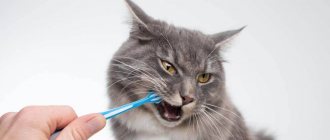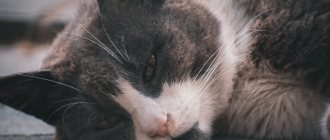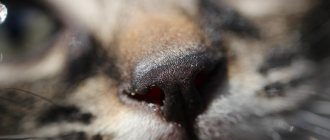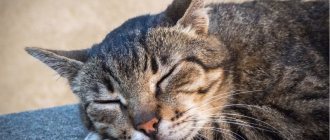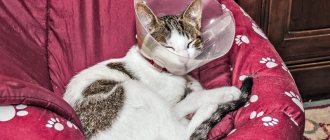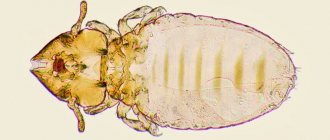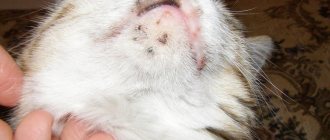The occurrence of rhinitis, or in other words, a runny nose, provokes the process of sneezing in cats. Unlike humans, this is the only way for an animal to get rid of mucous secretions accumulated in the nasal passages. The discharge has its own characteristic features depending on the reason that provoked the increased secretion production by the glands.
In addition, the discharge can be not only transparent, but also purulent, greenish or yellow, mixed with blood and an unpleasant odor.
There are many reasons for the appearance of discharge from the nasal passages, so the owner’s task is to promptly pay attention to the development of the pathological condition and take elimination measures. This means you need to consult a veterinarian without self-medicating. After diagnosis and prescribed treatment, strictly follow the doctor’s instructions.
Is nasal discharge a cause for concern?
If your cat's sneezing and/or nasal discharge is minor and she has a normal appetite and activity level, you just need to monitor her condition. To be on the safe side, it is better to isolate a cat with a “running” nose from other animals.
Chronic nasal discharge is a common symptom of viral and bacterial infections and should be taken seriously. However, most often, nasal discharge is associated with food or seasonal allergies.
Symptomatic diet and procedures
To make it easier for an animal to breathe before going to the hospital, its nasal passages must be cleared of crusts. This can be done using cotton wool and baby oil. You can soak the crusts using saline or boric acid (2% solution can be purchased at the pharmacy). The animal may resist when you help it, so you should wrap it in a blanket and hold it under your arm, or use the help of another family member.
Wet cleaning of the room and humidification of the air will help make nasal breathing easier for your animal; you can take your cat with you to the bathroom. While you take a shower or bathe, the cat will breathe moist air.
If the animal refuses to eat because it does not smell the aroma of the food, the food can be heated a little to enhance the aroma or poured with liquid from canned tuna to stimulate the animal's appetite.
It is important to provide the animal with constant access to clean water at room temperature.
In order for an ailment such as nasal discharge to occur to the animal as rarely as possible, it is important to carry out measures to generally strengthen the body. This is first of all:
- Adding active dietary supplements and vitamins to the diet.
- High-quality balanced nutrition.
- The use of general strengthening drugs, such as gamavit, immunofan, fosprenil, ibotan. Your veterinarian will help you calculate the dosage of medications.
You shouldn’t treat even the most harmless rhinitis in your pet. Frequent complications of untreated rhinitis are otitis (with subsequent complete loss of hearing), deformation of the muzzle, sinusitis, penetration of infectious agents into the brain (this condition threatens the life of the animal).
Take care of your pets, treat their illnesses on time!
Allergic rhinitis in cats
If you observe watery discharge accompanied by sneezing, it usually means your cat has ingested or inhaled an allergen from the environment. Allergies to non-food irritants, also known as atopy, were most likely inherited by your cat from her parents.
Note! Atopic allergy is an increased sensitivity to common allergens: plants and their waste products, mold, insect bites and dust mites, etc.
Discharge from the ear, or otorrhea
Allergy
Fungus
18047 June 24
IMPORTANT!
The information in this section cannot be used for self-diagnosis and self-treatment.
In case of pain or other exacerbation of the disease, diagnostic tests should be prescribed only by the attending physician. To make a diagnosis and properly prescribe treatment, you should contact your doctor. Discharge from the ear: causes of occurrence, what diseases cause it, diagnosis and treatment methods.
Definition
Earwax is a physiological secretion from the ear canal and protects the hearing aid from pathogenic bacteria. It contains lard, fatty acids and fat-like substances, as well as various mineral salts. Normally, a person produces 15–20 mg of earwax per month, which has the appearance of a sticky yellow-brown mass. All other discharges are considered pathological and indicate ear diseases.
Types of ear discharge
The discharge may be clear, white, light or dark yellow, or greenish (if there is pus). If blood enters the ear secretion, the discharge becomes reddish or brownish in color.
The consistency of the discharge may be watery, have a cheesy or flaky texture, and sometimes crusting may form.
An unpleasant smell of discharge due to the presence of pus in it can serve as a diagnostic sign.
What diseases and conditions cause discharge from the ear ? Wax plugs
. Excessive work of the sulfur glands leads to the formation of sulfur plug. Most often, this problem occurs in patients with diabetes mellitus, metabolic syndrome, and high cholesterol levels in the blood. The formation of cerumen plugs is provoked by increased viscosity of sulfur, dry skin, the entry of small foreign particles into the ear (for example, industrial dust), as well as excessive hair growth in the ear canal. Often, wax plugs are observed in people involved in water sports, using hearing aids, and miniature headphones.
With improper hygiene measures and independent attempts to remove excess earwax, there is a risk of pushing it deeper into the ear canal, thereby causing the formation of a plug.
Clinical signs of cerumen plug are pain and congestion in the ear, tinnitus, especially painful when the cerumen comes into contact with the eardrum, sometimes headache, dizziness, and nausea.
Mucopurulent and purulent discharge is a symptom of inflammation of the outer and middle ear. For inflammation of the outer ear (otitis externa)
the pathological process can develop in the auricle and external auditory canal (up to the eardrum). Most often, otitis externa occurs due to infection of the ear by bacteria and microscopic fungi. Its first signs are, as a rule, pain in the ear, itching, and, less often, hearing loss and a feeling of fullness. Mucopurulent discharge appears only with a widespread form of the inflammatory process throughout the entire ear canal.
The source of purulent discharge in the outer ear can also be a boil
located in the concha or ear canal.
With otitis media of the middle ear
, mucopurulent and purulent discharge becomes the result of infection of the sterile effusion from the inflamed tissues of the ear. Since the chamber of the middle ear is closed by the eardrum, purulent discharge can appear in the outer ear only after a hole has formed in it. This is preceded by severe pain in the ear, fever, decreased hearing, and in children - overexcitement, sometimes vomiting.
For mastoiditis
(inflammatory lesion of the mastoid process of the temporal bone), purulent discharge from the ear also appears. As a rule, this disease develops as a complication of otitis media and is accompanied by fever, pain and swelling in the mastoid area behind the ear.
Transparent bloody or purulent discharge appears with acute infectious myringitis
(inflammation of the eardrum), which may be of fungal or bacterial origin. Blisters filled with blood form on the surface of the eardrum, which then burst. In addition to the discharge, ear congestion is observed.
Transparent, colorless or slightly pinkish discharge from the ear can be a consequence of liquorrhea - the leakage of cerebrospinal fluid. It enters the auricle during fractures of the skull bones
(usually temporal) due to injury.
In addition, clear watery discharge sometimes accompanies allergic otitis
, which is also characterized by other symptoms - itching, ear congestion.
Unchanged blood appears from the ear, usually after injury and rupture of the eardrum
.
Such injury can occur after acoustic and mechanical shocks, as well as as a result of improper hygiene procedures. A ruptured eardrum is always accompanied by severe pain.
The appearance of bloody-purulent discharge from the ear is one of the indications of the presence of a polyp on the eardrum or the mucous membrane of the middle ear
. A polyp is a growth of tissue in response to irritation. The appearance of a polyp is preceded by active inflammation of the middle ear. In addition, polyps can be a consequence of myringitis, otitis externa, or malignant neoplasms. By perforating the eardrum, the polyp can protrude into the external auditory canal, leading to hearing loss.
Minor discharge, sometimes forming crusts and having an unpleasant odor, is characteristic of cholesteatoma.
– a tumor-like formation formed from the epidermis of the ear canal.
In most cases, cholesteatoma complicates chronic purulent epitympanitis
and is formed from layers of keratinized epidermis, water, proteins, fats and cholesterol. The formation of cholesteatoma is accompanied by feelings of heaviness and fullness in the ear, and headache. If left untreated, it can gradually invade the mastoid process and cranial cavity.
For otomycosis
loose cheesy discharge is observed. The main culprits of the disease are molds (usually localized in the outer ear) and yeast-like fungi (usually found in the middle ear). Clinical signs of otitis externa in these cases include pain and a colored, cheesy-necrotic discharge from the ear. Patients complain of tinnitus and dizziness.
A discharge that contains large, greasy flakes, sometimes mixed with pus, is characteristic of seborrheic ear dermatitis.
. The disease can affect not only the ear, but also the scalp. Clinical signs include severe itching, swelling of the ear, peeling skin and weeping wounds.
Transparent discharge mixed with blood (bloody discharge) indicates bullous, or influenza, otitis media.
. Bullae (bubbles of fluid) appear on the surface of the ear canal and eardrum. When they burst, the liquid with ichor flows through the ear canal into the auricle.
Which doctors should I contact for ear discharge?
In most cases, ear diseases are characterized by a clear clinical picture, which is based on pain. Such patients are treated by an otolaryngologist.
In the presence of a traumatic brain injury, which is accompanied by liquorrhea, urgent hospitalization is necessary. Otherwise, an unfavorable prognosis is possible.
Discharge from the ear is not always accompanied by pain, in particular with allergic otitis media, which is treated by, and.
Diagnosis and examinations for ear discharge
If the formation of a cerumen plug is suspected, the doctor performs an otoscopy, during which an accumulation of sulfur in the ear canal is detected. Diagnosis of external and otitis media is carried out on the basis of patient complaints, otoscopy, and palpation of the parotid area. It is recommended to culture the discharge from the ear to determine the causative agent of the disease and its sensitivity to antibiotics. Audiometric examination is possible.
Viral or respiratory diseases in cats
Thick and mucous discharge is a sign of a respiratory infection. It is important to understand that there are a lot of such infections and the diagnosis must be made by a veterinarian.
Viral diseases of cats that cause rhinitis:
- Actinomycosis.
- Viral peritonitis.
- Hemobartonellosis.
- Viral immunodeficiency.
- Calicivirus.
- Giardiasis.
- Mycoplasmosis.
- Panleukopenia (distemper).
- Parvovirus.
- Rhinotracheitis or herpes virus infection.
- Chlamydia.
A bacterial infection can cause chronic nasal discharge. If the discharge is thick, yellow and has an unpleasant odor - a bacterial infection, this is the most likely diagnosis.
Symptomatic treatment
If nasal discharge interferes with the animal’s full life, increases and changes in composition, then the cat must be shown to a doctor.
The veterinarian will assess the animal's condition. To make a more accurate diagnosis, the specialist will assess the cat’s general condition and well-being. He will also appreciate:
- the nature of the discharge (when it is more frequent, when, on the contrary, there is practically no discharge, whether the intensity of the discharge is affected by the activity of the animal, in what position of the body the flow from the nose is especially strong);
- abundance of discharge;
- does the discharge dry out and form crusts, or does the nose remain wet most of the time;
- is there snoring, sniffling, how much does the cat’s discharge bother him?
- where the discharge is localized: in both nostrils or only in one;
- Does the cat breathe through its nose while sleeping?
- how much the animal’s behavior changed when a runny nose appeared.
In accordance with the diagnosis, the specialist will prescribe treatment. It is important not to self-medicate and follow the doctor’s recommendations. It is also necessary to properly care for the animal’s sore nose, clean it of mucus, pus and crusts as carefully as possible so as not to damage the nasal passages.
So, in case of allergic reactions, it is not necessary to clean your nose of clear mucus. Veterinarians prescribe antihistamines, but they will only be effective if the allergen has been eliminated.
For rhinitis, the nose is washed with a 1% zinc sulfate solution or saline solution. You can warm your nose with bags of cereal heated in a frying pan.
For infections, it is important to correctly identify the pathogen and select the appropriate antibacterial, antiviral or antifungal drug. As a rule, relief occurs after 2-3 uses of the medicine.
If the animal’s nose is stuffy and it’s hard for him to breathe, then vasoconstrictor drops are used. But you should not abuse them - such drops are addictive. Drops are selected in children's dosage.
For tumors and polyps, doctors consider surgery. It is important to assess the depth of the tumor, the general condition of the animal, and concomitant diseases.
But it is worth remembering that if a foreign body gets into the cat’s nose, you cannot remove it yourself using cotton swabs or tweezers. This can push the object even deeper into the nostril and injure the mucous membrane!
Progression of chronic rhinitis
Regardless of whether the infection is viral or bacterial, the first discharge is watery and thin, and after 24–72 hours it becomes thicker, colored, and may acquire an unpleasant odor. In advanced stages of the disease, purulent discharge is observed.
Common causes of sneezing and chronic rhinitis in cats:
- Upper respiratory tract infection.
- Allergies or irritation of mucous membranes, for example, from smoke, dust, cleaning products, air fresheners, household chemicals.
- Diseases of the oral cavity and teeth.
- Foreign object in the nasal passage, polyps, neoplasms.
The cause of nasal discharge that periodically appears and goes away may be worms. Moreover, there are parasites whose eggs mature in the respiratory tract. The larvae hatch and begin to move, which irritate the respiratory tract, causing coughing, nasal discharge, sneezing and general malaise.
Secondary chronic rhinitis in cats
Cats are created to be unique and versatile. Wild animals keep their senses and teeth constantly clean. Domestic cats receiving an adapted diet do not have this opportunity. It is for this reason that more than 80% of cats over the age of 6 suffer from:
- Caries.
- Tartar.
- Various gum diseases.
Dental problems are a common cause of chronic nasal discharge in cats. Contact your veterinarian if you observe the following symptoms:
- Careful chewing or refusal to eat.
- Salivation.
- "Champing."
- Unpleasant odor from the mouth.
- Discharge from the eyes.
- Cough.
- Temperature increase.
- Ulcerative gum disease.
Another alarming symptom is noisy breathing through the mouth. Most often, open-mouth breathing indicates complete blockage of the nostrils. A similar picture can be observed when:
- Nasal congestion.
- Reporting.
- Neoplasms, including polyps.
Nasal infections can affect both your cat's overall health and her sense of smell. Nasal infections of a viral and bacterial nature can be “identified” by the following symptoms:
- Sneezing.
- Souring of the eyes.
- Refusal of food.
- Fever.
- A sharp decrease in activity.
Copious nasal discharge is observed with the following viral diseases:
- Herpes.
- Rhinotracheitis.
- Plague.
Note! Nasal discharge may be the first symptom of conjunctivitis, as the mucous membranes of the eyes and nose “communicate.”
Treatment of a runny nose
In order to cure rhinitis in a cat, it is necessary to consult a veterinarian, because he will not only help relieve snot as a consequence of the disease, but will also help fight the cause that caused it. Treatment depends on what the pet is sick with. A diagnosis can only be made if the necessary tests are obtained and then the veterinarian will prescribe the appropriate treatment, for example:
- If the animal cannot breathe at all, then it needs to be given urgent assistance: to free and clean the nasal passages with the help of rinses.
- Sometimes, if a kitten is dehydrated, an IV will have to be given.
- In order to prevent secondary infection from occurring, it is necessary to conduct a course of antibiotic therapy.
- Treatment of a runny nose is carried out using the drug Dioxycycline in the appropriate dosage.
- Fosprenil in the appropriate dosage.
- If your cat has a stuffy nose, you can rinse with baby Naphthyzine in the appropriate dosage as prescribed by the veterinarian.
- For treatment purposes, a technique such as quarantine and constant change of litter, as well as avoidance of drafts, is needed.
Treatment at home
If it is not possible to visit a veterinary clinic, you can treat it at home in the following ways:
- Treatment with warming has proven itself well. To do this, you can use warm salt or sand poured into a bag.
- You can wash with Boric acid and zinc sulfate.
- It is good to treat rhinitis with saline injections.
- Treatment with beetroot juice dripped into each nostril will help with a runny nose.
- If the animal cannot breathe due to nasal congestion, then it can be treated with saline and Ecmonovocillin.
- Streptocide, previously ground into powder and blown into each nostril of the cat, helps relieve the inflammatory process.
- If the pet has a serious condition due to the inability to breathe, then it can be instilled with children's Galazalin.
If a cat has problems with its nose and cannot breathe calmly, then you need to visit a veterinary clinic, only there they will help you decide on the right treatment.
In what cases is the help of a veterinarian needed?
- Sneezing and nasal discharge for 3 or more days.
- Intensive deterioration of the condition - the cat sneezes more often, the nose runs more strongly.
- The color and/or consistency of nasal discharge changes.
- Green, yellow, black, or bloody nasal discharge.
- Itching in the muzzle area.
- Noisy or hoarse breathing, snoring.
- Decreased appetite and activity level.
- Vomit.
- Photophobia.
- Fever.
- Anemia of the mucous membranes.
- Noticeable deterioration in wool quality.
- The appearance of crusts, cracks, scabs on the skin of the nose.
- Discharge from the eyes.
Runny nose in cats and why you shouldn’t use nose drops
Cat lovers often encounter or have heard about this problem. “The cat is sneezing!”, “the cat is sniffling!”, “can’t breathe through its nose!”, “some kind of discharge from the nose...” and so on. All these complaints can be combined into one medical term - rhinitis (inflammation of the nasal mucosa). Owners, by analogy with people, say: “I have a cold,” but in fact, in animals everything is much more complicated... A constantly stuffy nose reduces the activity of the animal, due to the loss of smell, appetite worsens, the “taste for life” disappears, so to speak, and some pathologies, accompanied by rhinitis, can even lead to death.
Because rhinitis is not a separate disease, but just a symptom. The task of the doctor and owner is to try to find the cause of rhinitis. Anamnesis (animal medical history, information from the owner), tests and hardware diagnostics can help with this. How to sort through the heap of proposed tests and examinations? It is sometimes difficult even for doctors, but there are points that need to be known.
Colds, we must remember once and for all: there is no such term! Yes, against the background of hypothermia, the protective properties of the immune system may decrease: the animal is more susceptible to viruses and bacteria. But warm-blooded animals have a constant body temperature, which can only be lowered by extreme conditions (falling through the ice, prolonged fasting, dehydration, toxins, blood loss, etc.), but not by an open window or a cold floor.
The main causes of rhinitis in cats:
- Viral diseases . Most often these are calicivirus and feline herpesvirus or infectious rhinotracheitis (IRT). Usually these viruses are not fatal, but they “spoil the blood” of owners and doctors due to their characteristics.
Calicivirus - causes ulcers in the oral cavity, mucous membranes of the lips, nose, causes rhinitis, in rare cases - pneumonia, lameness, skin lesions. The peculiarity of this virus is that it mutates very quickly, so vaccination, unfortunately, does not fully protect against the disease, that is, it protects, but only against the strains (varieties) that are included in the vaccine. To identify calicivirus, the doctor takes a scraping from the oral cavity with a special brush or cotton swab. The procedure is not painful.
Herpes virus (HRT) is a virus that affects 80-90% of the cat population and is transmitted at an early age from the mother. In small kittens it is accompanied by eye damage, in adult cats - by rhinitis. Kittens can even go blind, so treatment cannot be delayed! The peculiarity of this virus is that after the symptoms subside, the herpes virus goes to live in the nervous tissue (trigeminal nerve). And therefore, in some cats, under stress (the arrival of a new family member or pet, moving, repair work), RTI may again become active. Unfortunately, laboratory diagnosis is difficult: swabs from mucous membranes do not always reveal the virus; the cornea or trigeminal nerve is more informative. Due to their invasiveness, such tests are not relevant in practice.
Sometimes owners themselves infect their pets. Veterinarians regularly hear a story: they adopted a kitten that looked healthy, but the house cat got sick. Why is this happening? Because a kitten that has recovered from a viral disease sheds the virus for another 20 days. A newly arrived cat should be separated, ideally to another home. If the possibility is limited only to the provision of a separate room, then when in contact with a sick animal or carrier, gloves, shoe covers, a robe should be used, and all things should be removed when leaving the room.
Treatment consists of rinsing the nose, mouth, eyes, prescribing painkillers and, possibly (prescribed by a doctor), antibiotics. Antibiotics do not kill viruses, they are needed to suppress a secondary infection, which is never the root cause! Sometimes a doctor may prescribe a drug that suppresses the reproduction of herpesvirus, but usually, symptomatic treatment is sufficient. The effectiveness of immunostimulants has not been proven. But there are additional interferences that prevent the immune system from coping with infections. This is feline viral leukemia and immunodeficiency. They affect the very heart of the body - the immune system, so a cat suffering from leukemia or immunodeficiency simply cannot effectively cope with other, less dangerous viruses, despite the diligence of the doctor and owner. Chronic viral infections, also called viral leukemia and immunodeficiency, are difficult to diagnose, so several samples of material are required over a certain period of time.
- Foreign body in the nasal cavity . It seems like how could it get there? And, nevertheless, if you constantly observe discharge from one nostril, you definitely need to do a rhinoscopy. During rhinoscopy, the foreign body will be immediately removed and the cat will recover. It is very disappointing to hear cases where owners decided to undergo rhinoscopy after 2 years of useless treatment, and it turned out that a blade of grass was stuck in the nasal passages. Why don't people want to have rhinoscopy? Because it is a financial burden and anesthesia. The fear of anesthesia dates back to “ancient” times, when there were no veterinary anesthesiologists. In the era of modern equipment and the narrow focus of specialists, there is an anesthesiologist in every clinic, and even more so where rhinoscopy is performed. Obviously, no one wants to pay extra money, but if there are objective indications for rhinoscopy, you shouldn’t delay.
- In older cats, spontaneous discharge from this nostril may be due to a tumor of the nasal sinuses or ear . polyps are sometimes found in young cats . The diagnosis can be confirmed using MRI (soft tissue involvement), CT (bone structures). For the same reason as rhinoscopy, owners do not want to do these studies, very in vain: after all, while the tumor is small, it can be successfully removed, which is not always possible in advanced cases.
- An allergic reaction is extremely rare. Allergies that are accompanied by rhinitis occur at certain times of the year. Small particles such as construction dust can be irritating and cause rhinitis and cough.
- Also, the culprits of a runny nose are teeth and ears. The affected roots of the teeth serve as a source of infection, while the crowns of the teeth that we see may look healthy. For the most part, this is a pathology of older cats (after 10 years). The dentist determines the condition of the roots of the teeth by taking a dental x-ray under sedation . Pus in the middle ear sometimes causes signs of a respiratory infection. There is no way to defeat it with antibiotics; the source of infection must be removed. Diagnostics - otoscopy in the clinic, CT, MRI in complex cases.
So, we’ve come to the main question: WHY YOU SHOULD NOT PUT DROPS INTO A CAT’S NOSE. As you can see, due to a variety of reasons, this is simply not effective. There are no drops that can cure a tumor or reach a foreign body and cope with the virus. They are also not effective in humans. It’s just that the drops reduce the swelling and it seems to us that things are getting better. However, in cats, due to the anatomical shape of the nostrils, drops hardly penetrate. Perhaps most drops do not harm, but by dripping into your pet’s nose, reassuring yourself that you are treating without diagnosing, you are wasting the animal’s precious time.
A few words about treatment.
1. The doctor should tell you approximately when improvement will occur; if it does not, a repeat visit to the veterinary clinic is needed.
- Some drops can be used after rhinoscopy for 3 days to relieve swelling. If used for longer, even greater swelling of the nasal mucosa is possible.
- If there is heavy thick discharge, nasal rinsing is prescribed in the clinic. If regular rinsing does not help, and the discharge is thick, sometimes it is rinsed under sedation (for this you can use 2 liters of saline, with the obligatory installation of a tracheal tube). If the doctor looks at your request with round eyes and a slightly open mouth, go to another clinic.
- Search for the reason. No matter how you want it, you have to! If your runny nose miraculously went away and you treated it with drops, it’s just a coincidence. Without eliminating the cause, after 7 days of taking it, rhinitis will return.
- Follow your doctor's orders, especially antibiotic therapy. Tell your doctor honestly if you have not given or are not going to give antibiotics. You should not change the antibiotic yourself; you should think about changing it if there is no effect after 7 days of use. Another antibacterial drug is usually selected based on culture results.
- In case of illness of the oral cavity, pharynx and a number of other reasons, when the animal does not eat for a long time and force-feeding is impossible, it is better to insert an esophageal tube. A very convenient thing, especially for the animal.
- If the cat suffers from chronic rhinitis (chronic viral infections, herpes virus, seasonal allergies) or after rhinoscopy, you should not spray any aerosols on it or smoke. During repairs, isolate from dust. These actions will prevent exacerbation and worsening of symptoms.
And remember: doctors without the support of the owner will not be able to cure the animal!
Health to you and your animals!
